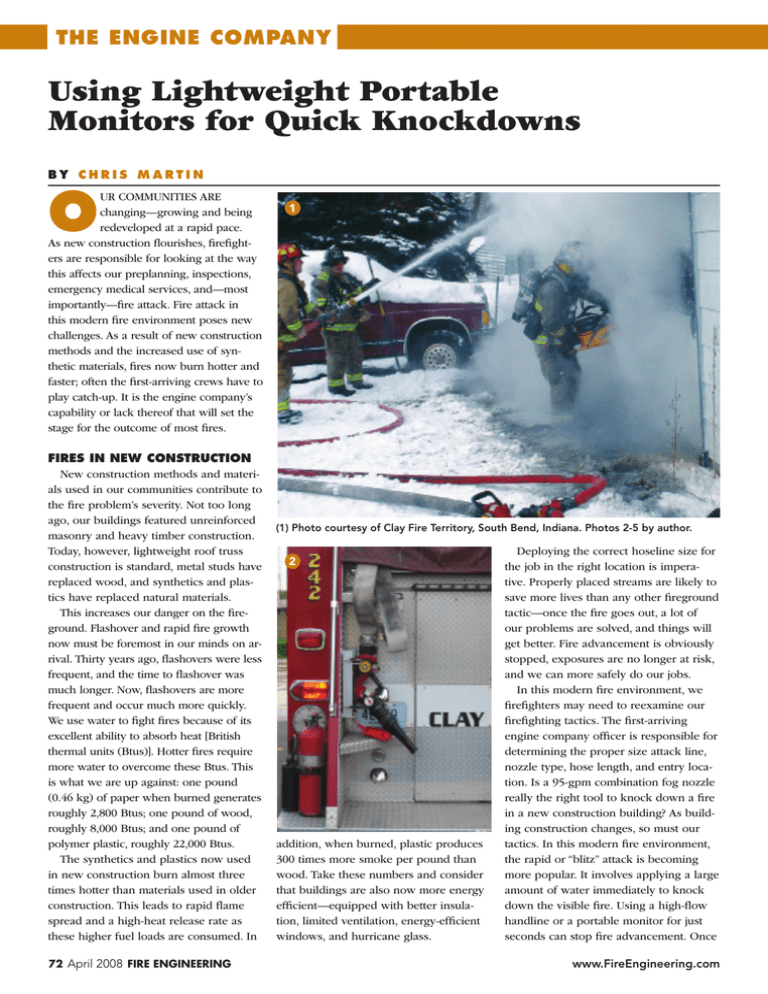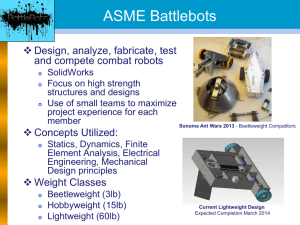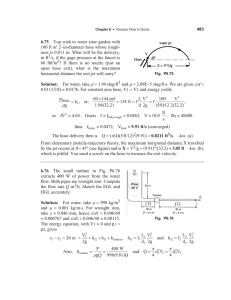Using Lightweight Portable Monitors for Quick
advertisement

the engine company Using Lightweight Portable Monitors for Quick Knockdowns BY CHRIS MARTIN O ur communities are changing—growing and being redeveloped at a rapid pace. As new construction flourishes, firefighters are responsible for looking at the way this affects our preplanning, inspections, emergency medical services, and—most importantly—fire attack. Fire attack in this modern fire environment poses new challenges. As a result of new construction methods and the increased use of synthetic materials, fires now burn hotter and faster; often the first-arriving crews have to play catch-up. It is the engine company’s capability or lack thereof that will set the stage for the outcome of most fires. FIRES IN NEW CONSTRUCTION New construction methods and materials used in our communities contribute to the fire problem’s severity. Not too long ago, our buildings featured unreinforced masonry and heavy timber construction. Today, however, lightweight roof truss construction is standard, metal studs have replaced wood, and synthetics and plastics have replaced natural materials. This increases our danger on the fireground. Flashover and rapid fire growth now must be foremost in our minds on arrival. Thirty years ago, flashovers were less frequent, and the time to flashover was much longer. Now, flashovers are more frequent and occur much more quickly. We use water to fight fires because of its excellent ability to absorb heat [British thermal units (Btus)]. Hotter fires require more water to overcome these Btus. This is what we are up against: one pound (0.46 kg) of paper when burned generates roughly 2,800 Btus; one pound of wood, roughly 8,000 Btus; and one pound of polymer plastic, roughly 22,000 Btus. The synthetics and plastics now used in new construction burn almost three times hotter than materials used in older construction. This leads to rapid flame spread and a high-heat release rate as these higher fuel loads are consumed. In 72 April 2008 FIRE ENGINEERING 1 (1) Photo courtesy of Clay Fire Territory, South Bend, Indiana. Photos 2-5 by author. 2 addition, when burned, plastic produces 300 times more smoke per pound than wood. Take these numbers and consider that buildings are also now more energy efficient—equipped with better insulation, limited ventilation, energy-efficient windows, and hurricane glass. Deploying the correct hoseline size for the job in the right location is imperative. Properly placed streams are likely to save more lives than any other fireground tactic—once the fire goes out, a lot of our problems are solved, and things will get better. Fire advancement is obviously stopped, exposures are no longer at risk, and we can more safely do our jobs. In this modern fire environment, we firefighters may need to reexamine our firefighting tactics. The first-arriving engine company officer is responsible for determining the proper size attack line, nozzle type, hose length, and entry location. Is a 95-gpm combination fog nozzle really the right tool to knock down a fire in a new construction building? As building construction changes, so must our tactics. In this modern fire environment, the rapid or “blitz” attack is becoming more popular. It involves applying a large amount of water immediately to knock down the visible fire. Using a high-flow handline or a portable monitor for just seconds can stop fire advancement. Once www.FireEngineering.com the engine company 3 the fire is darkened down, handlines can be advanced to extinguish the fire completely (photo 1). The quicker we do this, the quicker things get better. Never use this type of attack if the building is occupied by civilians or firefighters. RAPID ATTACK A lightweight portable monitor can achieve quick knockdown rapidly, effectively, and with limited staffing. Several makes and models are on the market, each with its own features and benefits. A 4 lightweight portable monitor weighs less than 20 pounds and can deliver around 500 gpm from one 21⁄2-inch or three-inch hoseline. Since it is often preconnected (photo 2), one firefighter can easily deploy this monitor to put a lot of water on the fire fast. This attack must be coordinated with other crews on the fireground; when executed properly, it will knock down a large amount of the fire quickly. Remember that depending on the volume and involvement of the fire, this rapid attack will last only about 15 to 30 seconds, Enter 150 at fireeng.hotims.com until the visible fire is darkened down. Once this occurs, crews can make entry to locate, confine, and extinguish the rest of fire. The rapid attack tactic merely halts the fire temporarily; an aggressive crew must still get inside and put the rest of the fire out completely. However, this task will be significantly easier and safer, since the bulk of the fire has been extinguished. ADVANCING HANDLINES Once the rapid attack has occurred, you can use the lightweight portable monitor the engine company as a manifold from which to advance handlines. Typically, the more popular monitors have a built-in shutoff. This allows the firefighter to shut off the monitor, attach a gated wye or reducer, and advance a handline directly from the monitor (photos 3, 4). This setup is ideal for times when firefighter staffing is limited; firefighters can carry a separate hose pack that includes a break-apart nozzle combination with a separate shutoff and nozzle tip (photo 5). As the hoseline is advanced from the lightweight portable monitor, if additional hose is needed, the nozzle shutoff can be closed, the nozzle tip removed, and an additional hose bundle attached to the shutoff. This allows quick advancement of additional hose without shutting down the entire operation. The gated wye is what makes this lightweight portable monitor a manifold to which an additional hoseline can be attached. Keep in mind that certain brands of monitors come equipped 5 with a safety shutoff that activates if the monitor is moved slightly. This feature can pose a problem when the monitor is used as a manifold, since the monitor could accidentally shut off if it is moved when advancing hose. It may be necessary to secure it in the open position with a piece of rope or webbing to ensure that your water supply is not compromised. ••• If used properly, the lightweight portable monitor is an effective and safer tactic for facing the new enemy—the modern fire environment. If there is no threat to the occupants, why endanger firefighters’ lives? With a rapid attack, we can minimize many dangers that new building construction poses. One way to achieve this is a quick knockdown with a lightweight portable monitor, followed with a much safer aggressive interior attack using the monitor as your water supply. This is just one more tactic for us to add to our playbook—one that can help to ensure safety. ● Author’s note: Thanks to Engineer (Ret.) Mac McGarry of the Glenview (IL) Fire Department for his help with this article. ● CHRIS MARTIN is an 11-year veteran of the fire service and an engineer with the Clay Fire Territory in South Bend, Indiana. He is an Indiana-certified fire officer 1, EMT-B, and fire instructor. Martin has a bachelor’s degree in marketing from the University of Notre Dame and is a member of the MABAS Division 201 Tactical Rescue Team. Enter 152 at fireeng.hotims.com www.FireEngineering.com




